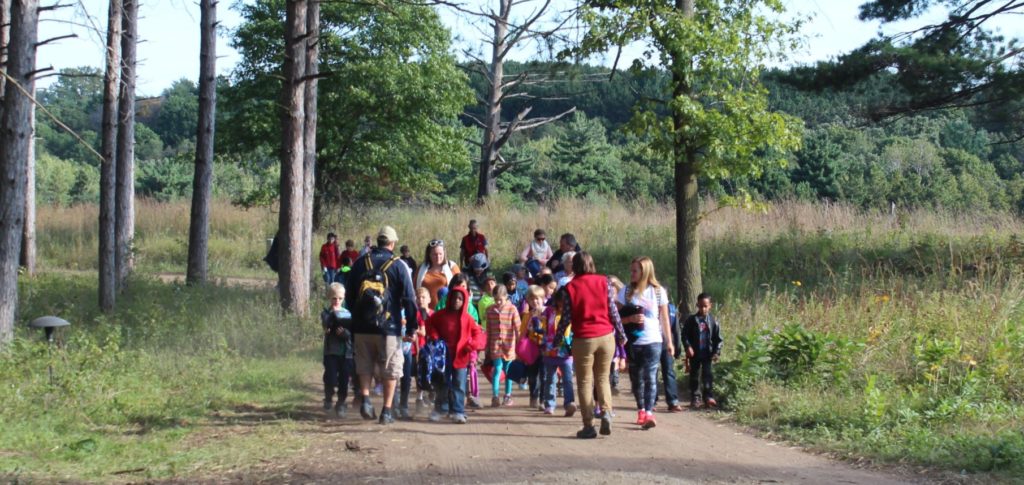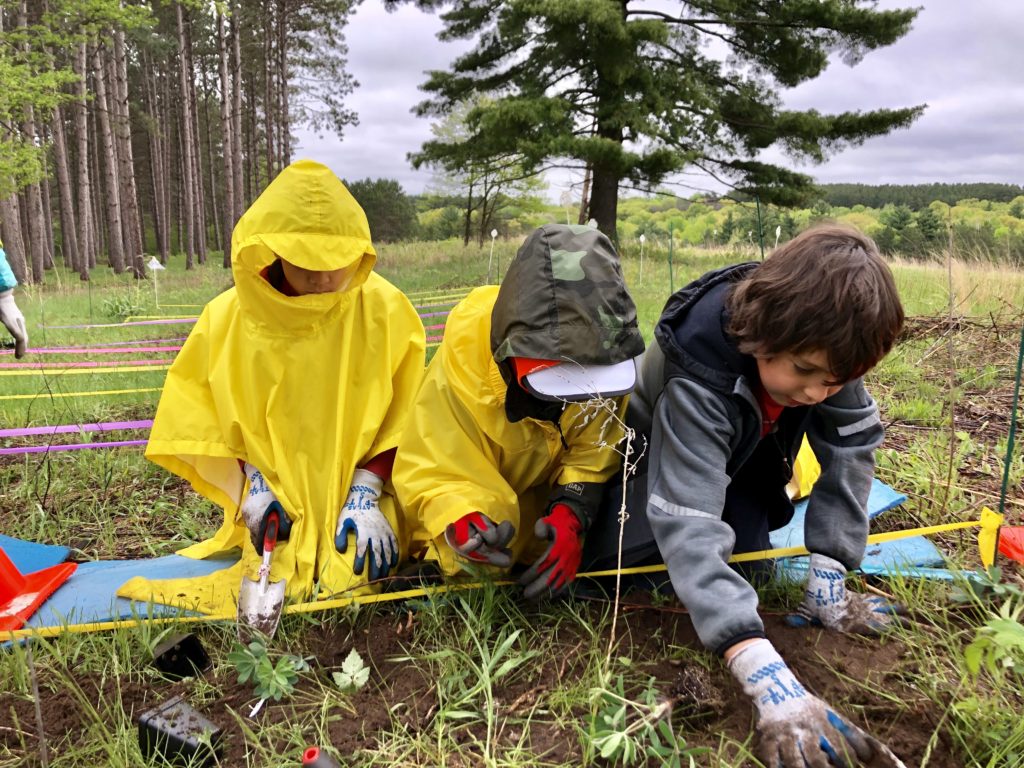“The human child in nature may well be the most important indicator species of future sustainability.”
– Richard Louv, author of Last Child in the Woods
Published September 3, 2016
The year was 1970 and issues facing conservationists then were strikingly similar to what we face today: over-development of ecologically important land and children spending less time in the outdoors.
It was at this time that Charles Bell and Lucy Winton Bell found themselves in a unique position to do something to help address those challenges. They had recently acquired more than 200 acres of ecologically diverse land in Afton and were looking for a partner with whom to bring outdoor education to children.
Meetings with a variety of organizations bore no fruit until the couple heard about Rod Frye, a teacher from Saint Paul Public Schools (SPPS) who was looking for a place to host outdoor science education for students in the district. Bell and Frye met and from that meeting a new partnership was born: Belwin Outdoor Science Laboratory, today referred to as Belwin Outdoor Science.

The unique partnership established that the Bell family would give SPPS access to the property and the Bell family would manage it, and SPPS would design and manage the curriculum. Congruent with their land-preservation goals, the Bells also required that the land be restricted to use by SPPS only, meaning no public use of the facility for recreation. The acreage would be dedicated to children’s outdoor science education for as long as possible.
45 years later, the partnership endures, much the same as it was the first year students visited the Belwin property in 1971.
The outdoor learning environment
What Charles Bell and Lucy Winton Bell knew, in the 1970s, is something that many people today are just coming to appreciate: that children need time immersed in nature to fully understand the interconnectedness of the world, and that the time is beneficial to overall health and well-being.
In his 2006 book, Last Child in the Woods, Richard Louv explored the connection between the time children spend outdoors and the rise in the rates of childhood obesity, attention disorders and depression. Louv found that the solution to these challenges is often right in our own backyards.
“At the very moment that the bond is breaking between the young and the natural world, a growing body of research links our mental, physical, and spiritual health directly to our association with nature — in positive ways,” said Louv. “Several of these studies suggest that thoughtful exposure of youngsters to nature can even be a powerful form of therapy for attention-deficit disorders and other maladies. As one scientist puts it, we can now assume that just as children need good nutrition and adequate sleep, they may very well need contact with nature.”1
There are also many teachers today who understand what Bell and Frye advocated nearly five decades ago: that to truly bring education to life, kids need to be exposed to a variety of learning environments, inside and out.
“Kids don’t get outside enough,” says Josh Leonard, Belwin Outdoor Science education director and former teacher at Como Park Senior High School. “Our society in general is not connected to nature. Establishing that connection to nature is so important.”

David Hartwell, grandson of Charles and Lucy, and Belwin Conservancy board president, was 5 years old when Belwin Outdoor Science welcomed its first students. He has dedicated his life to ensuring land preservation, here in Minnesota and in other communities throughout the world, and sees outdoor education as a critical component of learning when paired with lessons from the classroom. Hartwell illustrates his point using the example of learning how to drive a car.
“You can learn how brakes work, how the accelerator works, etcetera, but that doesn’t mean you know how to drive a car,” he says. “You can’t understand the outdoors by studying out of a book or looking at pictures. You don’t get the smells, the wind blowing in your face. You don’t have the tactile experience that is important to our lives.”
Education outside of the classroom also affects student achievement and learning. In a 2002 report for California called “Closing the Achievement Gap,” Gerald Lieberman shared the results of his work with 150 schools in 16 states over 10 years. He identified model programs in place-based education or experiential learning, and examined how students in those programs fared on standardized tests. The results? “Students in the schools achieved gains in social studies, science, language arts and math; improved their grade-point averages; and developed skills in problem-solving, critical thinking and decision-making.”2
In another study, “Effects of Outdoor Education Programs for Children in California” by the American Institutes for Research, 56% of at-risk youth reported never having spent time in a natural setting. Once they did, there was a 27% increase in measured mastery of science concepts, as well as gains in positive environmental behaviors and gains in problem-solving, motivation to learn and classroom behavior.3
Shared responsibility
Remarkably, 50 years of partnership, the arrangement between Belwin and SPPS remains in place today. “The intention was to share the property with a school system looking for a place to provide an outdoor educational lab. We didn’t want to run an educational program; they didn’t want to manage a facility,” David Hartwell says.
The partnership allows both parties to focus on what they do best: Belwin maintains 225 acres dedicated to outdoor education, including the education center (built specifically for the program), 6 miles of trails (2 miles are handicap-accessible), and a classroom dedicated to children with physical and emotional needs; Saint Paul Public Schools sets and teaches the curriculum, and buses the students to and from Belwin.  Belwin Outdoor Science gives every third-grader and fifth-grader in SPPS a day spent out of doors, connecting with a unique natural environment less than 30 minutes from home. The SPPS program is based on Minnesota Science Standards and specializes in life science and nature of science standards, with more than 20 classes offered.
Belwin Outdoor Science gives every third-grader and fifth-grader in SPPS a day spent out of doors, connecting with a unique natural environment less than 30 minutes from home. The SPPS program is based on Minnesota Science Standards and specializes in life science and nature of science standards, with more than 20 classes offered.
“About 30 percent of fifth-grade students in the district are proficient in science,” Josh Leonard says. “They maybe only get 40-50 hours of science contact time in the school year. They spend four hours at Belwin, so 10 percent of their science contact time is here at Belwin. This program is a really important piece of their science foundation.”
More than 10,000 students visit each year, exploring the property in all types of weather: sun and heat, rain and snow. They track animals, study plant life and aquatic species, learn to cross-country ski and snowshoe. Since 1971, more than 500,000 students have participated in the Belwin Outdoor Science program.
Perhaps one of the most important but least anticipated results of the program is that students overcome language barriers when they are outdoors together.
Only at Belwin
The original 5,000-square-foot Belwin Education Center was built in 1970-1971, with funds from the Belwin Foundation and many other friends and foundations, and is still in use today. When children arrive, they gather in a large reception area, flanked by classrooms and offices, and start their day meeting with teachers from Belwin Outdoor Science.
The Belwin teachers—paid environmental educators, not volunteers—present on what students will be learning, instruct on any equipment that will be used, and outline rules for the day. Staying on trails, respecting adjoining private property, and preserving the natural environment are stressed.
Then it’s off to explore the outdoors. The recently renovated observation tower is a highlight for many of the children, and stop along their hike might include Kettelkamp Prairie, Woodland Pothole, Beaver Outlook and Bullrush Slough. When students are at Belwin Outdoor Science, they are the exclusive visitors for the day; the property is not open to the general public.

The children often have a lot of questions about the animals at Belwin, many of them worrying about what to do when an animal attacks. “My retort is to ask them what they think the scariest thing is at Belwin,” says Leonard. “They think we have cheetah and lions here. I have to remind them that the humans are the scariest thing here.”
Natalie Spencer is a Belwin Outdoor Science education assistant who first experienced Belwin as an SPPS student. “For many of our students, being at Belwin may be their first time outside of St. Paul, and being in new and unfamiliar places can be scary,” she says. “Our job is to alleviate that fear by making students feel safe. Our hope is to give all our students a positive experience in nature.”
May Vang is a former education assistant/instructor with Belwin Outdoor Science and also first connected with Belwin as an SPPS student. What makes Belwin a unique experience for the students, she says, is the diversity of the land and ecosystems, and the privacy that Belwin offers.
“It makes such a big difference that Belwin is private land. Students feel like it’s a special place because they are the only group here. I think it would feel different if we bumped into the public hiking around while we are teaching our lessons,” Vang says. “Belwin also has a wild and very natural feeling to it as soon as we step out of the [education center]. We don’t have to go far to have [the kids] to feel like they are deep in the wilderness.”
One of the biggest differences between Belwin and other Twin Cities-area nature-based programs is the class size and ratio of kids to teachers. “When kids come here, they’re in a small group environment with a professional naturalist and professional instructor. That’s huge!” says Leonard. “Lots of nature centers have large groups, of 20 to 30 kids. Those kids might connect with a naturalist for 30 minutes or maybe an hour in a large group context. At Belwin, kids get split up immediately into five smaller groups of about 10 kids per instructor. They are learning so much and are much more immersed in the environment. They also get out on the trails more, since we don’t have a lot of interactive exhibits in the education center.”
Long-term investment
Belwin’s commitment to the SPPS program remains strong. In 2016, it completed phase one of a multi-phase project to remodel the Education Center, at a cost of more than $60,000. This was funded by Belwin members, the Donald Weesner Foundation and a matching grant from the James Ford Bell Foundation.
The next phases of investment in Belwin Outdoor Science include a new lower classroom (the original was brought to the site in the 1980s), and maintaining the partnership with SPPS.
Sources
1Last Child in the Woods, Richard Louv. (http://richardlouv.com/books/last-child/excerpt/)
2“The School of Nature: Greening Our Schools May Be The Real Cutting Edge of Education.” (http://richardlouv.com/blog/the-school-of-nature-greening-our-schools-may-be-the-real-cutting-edge-of-e/)
3American Institutes for Research “Effects of Outdoor Education Programs for Children in California.”